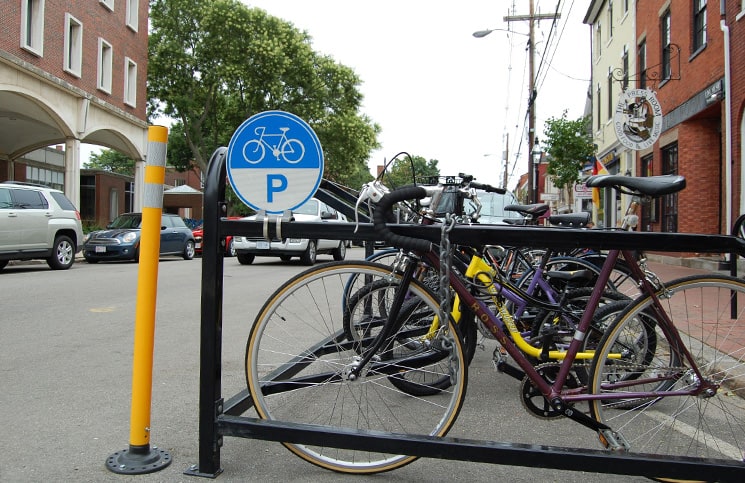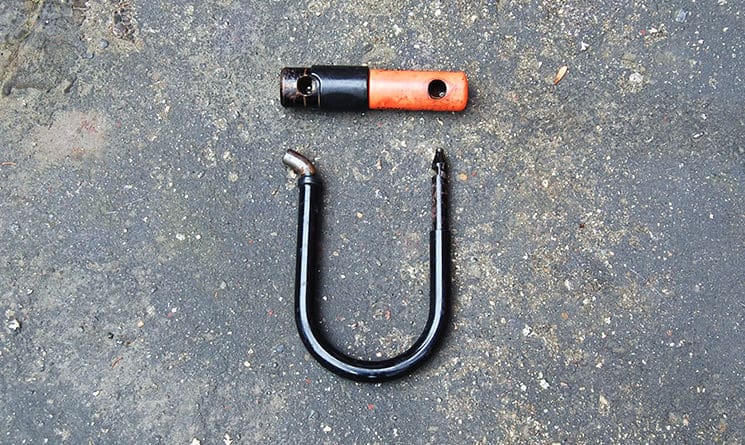If you want to get really excited about the Seacoast’s progress toward bike-friendly status, it’s best not to compare it to bicycle powerhouses around the world. Vincent Van Gough’s “Starry Night” will not appear across any bike paths with solar panels, as it has in the Netherlands. Coffee shops here don’t have more bike parking than chairs, like Fresh Pot in Portland, Ore.
But there may be a quiet renaissance happening in the Seacoast. Earlier this summer, Portsmouth earned a bronze-level “Bicycle Friendly Community” designation from the League of American Bicyclists. The award was an important recognition for the city, which last year adopted a bicycle and pedestrian master plan.
Under the plan, which will likely take 10 to 15 years to fully complete, the city could more than triple the amount of bicycle infrastructure, from 18 to 58 miles, according to Juliet Walker, the city’s transportation planner. That’s about 35 percent of the city’s total road network and would include on-road lanes, sharrows (road markings indicating shared space for bikes and vehicles), and off-road paths.
“Most people should feel they can do their daily activities by bike,” Walker said.
And that’s exactly what Josh Pierce believes the Seacoast is looking for. When he moved here in 1999, he said, there was a small core group of cyclists — some commuters, but mainly recreational riders. Now, the general manager of Papa Wheelies and president of Seacoast Area Bicycle Riders (SABR) said he sees that core expanding.
“There has been a groundswell of people riding bikes for commuting, transportation, for running errands,” Pierce said. “There are a lot of people that I see at the bike shop who came in as newbie customers five or six years ago, got a bike, and have since turned into a lot more serious (riders).”
Getting started
The city’s path toward a more bike-friendly future is already being carved. In fact, the past few years have included some large leaps already recognized by cyclists of all levels.
The most noticeable is the Memorial Bridge, which connects downtown Portsmouth to Kittery, Maine. Years of meetings and work between the city, bicycle advocates, and the states of New Hampshire and Maine ensured the downtown connection would have dedicated space for cyclists and pedestrians — a far cry from the previous bridge, which crammed both to the margins.
The result is that the bridge is now “a destination in and of itself,” Walker said, and a link for residents on both sides of the Piscataqua River who want to forgo cars. “The reason that was so successful was there was quite a large stakeholder group involved in the process from the beginning,” Walker said.
The city has also focused on easing commuter traffic around Pease International Tradeport and opening up a bike route that is safer for cyclists who ride to work. The Pease Multi-Use Path was completed in the last year after a decade of collaboration between the city, the state Department of Transportation, the Pease Development Authority, and SABR.
This bike path allows cyclists to bypass the congested stretch of road near the Grafton Drive entrance of Pease at Route 33 by using a 10-foot paved path that intersects with Corporate Drive. After a short on-road section, cyclists can connect to the previously constructed bike and pedestrian path that crosses over the Spaulding Turnpike and ends near the Portsmouth Traffic Circle at Woodbury Avenue.

Bike corrals, like this one on Daniel Street in Portsmouth, are part of the city’s ongoing efforts to be more bike-friendly.
These large-scale projects complement some smaller measures, including the addition of two new bike corrals downtown: one at the intersection of Daniel and Penhallow streets, and the other at Market and Hanover streets. The idea is that the improvements will encourage more residents to opt for using bicycles instead of cars.
“It’s something you don’t have to be a super athlete to do,” Pierce said. “Anybody can ride a bike. It’s one of the great things about riding a bike; you can be 6 or you can be 96. Just take your time and figure it out.”
Making connections
When Walker and Pierce talk about the future of transportation in the city, they focus on the big picture. Do the city’s streets allow for the inclusion of all transit options — car, bike, bus, and foot? Bicycle advocates often refer to this concept as the “complete streets” approach.
“The idea is to build it to accommodate everybody who is using it,” Pierce said. “If you do that, you will encourage people to ride bikes on it, encourage people to walk on it. You are going to slow traffic down a bit, but that’s probably a good thing in densely populated places.”
In addition to ensuring residents and visitors can get around using various types of transportation, Walker and Pierce want to make sure cyclists can get around the whole city safely, without having to make dangerous connections between bike paths. This is a particular concern in a region where many roads were not built for cars and bikes.
“The good and the bad of the area around here is there are lots of quiet roads, but they were built 300-plus years ago for horse and carriage, so shoulders are minimal, if not non-existent,” Pierce said.
And so, with each new road project, the city is looking for opportunities to incorporate bikes. When a road construction project was planned for Sagamore Avenue, the city added lanes for the popular bike route that takes riders toward Rye beaches.
The city is also beginning a project along Middle Street and Lafayette Road that will link neighborhoods to downtown and provide a safe path for students seeking a connection to Portsmouth High School, Portsmouth Middle School, the library, and Leary Field. Design meetings for this project are planned for September, with construction slated to begin in spring.
The corridor between Andrew Jarvis Drive — the entrance to Portsmouth High School — and Wibird Street are planned to include buffered bike lanes that would be separated from the road. The northern corridor, from Wibird Street to Congress Street, would have a mix of separate bike lanes and shared bike lanes, Walker said.
“We hope this would encourage more kids who want to ride their bikes to school,” Walker said.
The city is also waiting to begin construction on another large project that would turn the abandoned Hampton Rail Trail into a dedicated bike and pedestrian path that would eventually run from Portsmouth to Hampton and potentially down to Massachusetts. The first phase of this project would be a 0.8-mile segment between Barberry Lane and Route 33 and would eventually include trailheads at Barberry Lane, Greenland Road, and Ocean Road.
The city has already allocated $500,000 for this project and is waiting for the state to gain ownership of the property before beginning construction. Once completed, the off-road trail would become part of the East Coast Greenway, a 2,900-mile stretch of bicycle and pedestrian routes between Florida and Maine. If completed, conversion of the abandoned railway into bike and pedestrian paths would add 17.2 miles of off-road path, according to the East Coast Greenway website. The southernmost portion of this — 4.5 miles from the Massachusetts border into Seabrook – has already been acquired by the state. The rest is pending sale.
Other planned bike improvements in Portsmouth include:
Market Street: Bike lanes are planned for both sides of the street from the I-95 ramp to Deer Street, along with a shared-use path on the north side of the street and bicycle and pedestrian connections to Albacore Submarine Park.
Maplewood Avenue: In conjunction with planed water a

